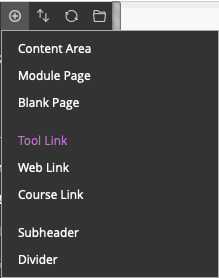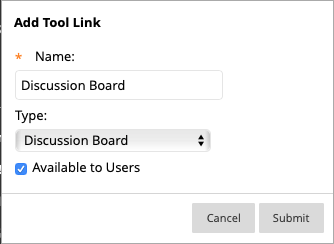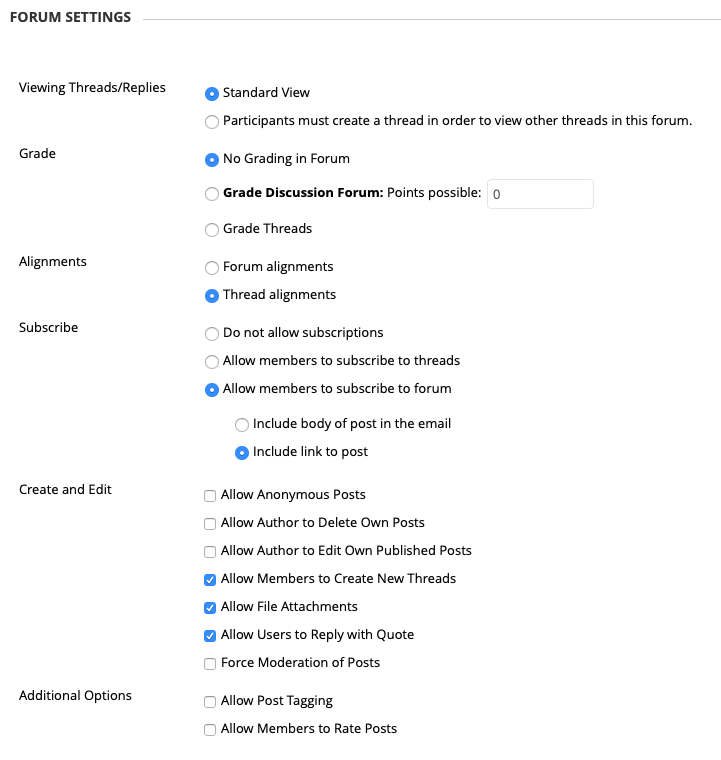

Blackboard's Discussion Board is a tool for facilitating asynchronous conversations among your students. Typically, the instructor will pose a question and, over the course of the next several hours or days, students will respond to the instructor and to each other.
To add a Discussion Board to your course, click on the + button in the course menu, and select Tool Link. In the pull down menu, select Discussion Board, name the link (we recommend Discussions, or Discussion Board), and make sure to check the box to make the link Available to Users, or students won't see it.


Within the Discussion Board, there can be one or more Forums, which you can think of as particular discussion topics. Each forum can (if you select this option) have one or more Threads, which you can think of as spinoff conversations originating from the forum topic. You have the option to let students edit or delete their posts, start their own threads, post anonymously (but these are not gradable), and you can also moderate posts, which requires you to approve them before they become public. You can avoid a lot of problems by setting expectations around etiquette.
Watch this video for an overview of setting up discussion forums and threads:
Getting Started: For your first discussion, keep it simple by doing a forum. Assign a small point value. Disallow the creation of new threads. Be sure to create the first "seed post" or starting question, because the students won't be able to respond until you get them started. Provide feedback, and encourage them to expand on the interesting early posts. Don't avoid controversy, but insist that everyone is respectful.
Settings: There are many settings to choose from. Changing some settings will affect other options. It's good to consult with an instructional designer to go over all of these options, because they can be a bit overwhelming. Your ID can also offer advice on grading and ways to engage students with good seed questions.

Grading with Rubrics: Discussions are sometimes more effective if you use a rubric that shows students how their posts will be graded. (Rubric options only appear when you make discussions gradable.) Encourage your students to post comments that have not already been posted by someone else, and for substantive comments rather than "She said what I was going to say." Posts should make a meaningful contribution to the topic and keep the conversation going. Encourage your students to back up their arguments with evidence, and avoid making personal attacks on others.
Discussion Post Rubric Grading Criteria Maximum: 10 points |
Substance of Post: Quality of Argument, Supporting Evidence, Tactfulness, etc. |
|||
| Minimal (0 points) | Partial (2.5 point) | Full (5 points) | ||
Style of Post: Grammar, Punctuation, Spelling, etc. |
Minimal (0 points) | 0 | 2.5 | 5 |
| Partial (2.5 points) | 2.5 | 5 | 7.5 | |
| Full (5 points) | 5 | 7.5 | 10 | |
A basic rubric with a maximum of 10 points.
Direct Links to Forums or Threads: As you build more discussion forums or threads, you may want to create direct links to each one. You can create a Course Link either in the course menu or the content area, which points directly to a forum or thread rather than to the general Discussion Board.
Guiding students in discussions can be challenging. Writing good initial questions that are thought provoking and open ended is effective. Providing feedback that encourages meaningful responses and keeps the conversation going should be the goal. Too little input implies you're not reading their responses. Too much input from the instructor can also stifle the conversation or drive it in directions students think you want it to go. Often, faculty require a set number of original posts and replies to each thread, but that can lead to a transactional response from students, who participate only enough to get the points. Here's a good article with advice.